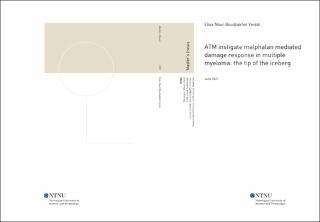| dc.contributor.advisor | Starheim, Kristian | |
| dc.contributor.author | Veidal, Elias | |
| dc.date.accessioned | 2021-09-25T16:35:06Z | |
| dc.date.available | 2021-09-25T16:35:06Z | |
| dc.date.issued | 2021 | |
| dc.identifier | no.ntnu:inspera:77744542:49983730 | |
| dc.identifier.uri | https://hdl.handle.net/11250/2783317 | |
| dc.description.abstract | INNLEDNING: Myelomatose (MM) er en uhelbredelig hematologisk krefttype preget av hyperproliferasjon av plasmaceller. Sykdommens robusthet skyldes utvikling av resistens og tilbakefall av sykdommen. Forekomst av minimal restsykdom (MRD) etter behandling regnes som den viktigste årsaken til tilbakefall. Myelom celler kan signalere overlevelse gjennom signalveiene NF-κB og MAPK, begge regulert av kinasen TAK1. NF-κB og MAPK-aktivering kan også føre til produksjon av pro-inflammatoriske mediatorer, noe som skaper et gunstig miljø for tumorvekst. TAK1 regnes også som en hemmer av apoptose siden NF-κB er motregulert med RIPK1-avhengig apoptose. En signalvei aktivert av alkylatoren melfalan, ofte brukt i MM-terapi. Melfalan induserer irreversibel DNA-skade som aktiverer TAK1 og endrer skjebnen til cellen fra apoptotisk død til overlevelse. Derfor reduserer inhibering av TAK1 viabiliteten i myelom celler både alene og i kombinasjon med melfalan. Inhibering av TAK1 reduserer også utrykkningen av gener regulert av den onkogene transkripsjonsfaktoren Myc.
FORMÅL: Denne oppgaven undersøker om melfalan aktiverer TAK1, MAPK og NF-κB gjennom ATM. Utforsker om TAK1-hemming kan nøytralisere produksjonen av pro-inflammatoriske cytokiner i myelomceller. Prøver å avgjøre om den NG25-induserte reduksjonen i Myc-kontrollerte gener er reflektert på nivået av Myc-aktivitet.
METODER: I denne studien ble eksperimentell data samlet inn fra MM-cellelinjer ved enzyme-linked immunosorbent assay (ELISA) og western blot. Western blot ble brukt til å måle proteinmengde og oppdage proteinmodifikasjoner. ELISA ble anvendt for å måle konsentrasjonen av pro-inflammatoriske cytokiner utskilt i mediet. Cellene ble utsatt for melfalan, NG25 eller KU-55933 avhengig av eksperimentets hensikt.
RESULTATER: Fosforylering av ATM ble observert etter melfalan behandling i INA-6-celler. ATM-hemming reduserte fosforylering av TAK1, IκBα og p38 i INA-6-celler. NG25 blokkerte produksjonen av MCP1 i INA-6-celler. Melfalan og NG25, begge reduserte Myc-nivåene i cellelinjene INA-6, ANBL-6, JJN3 og RPMI-8226.
KONKLUSJON: Melfalan induserer en DNA-skadesrespons initiert av ATM, som aktiverer NF-κB og MAPK gjennom TAK1. TAK1-inhibering blokkerer produksjonen av MCP1 og reduserer Myc-nivåene. | |
| dc.description.abstract | INTRODUCTION: Multiple myeloma (MM) is an incurable hematological cancer characterized by hyperproliferation of plasma cells. The disease’s persistence is due to the development of drug resistance and relapse. The presence of minimal residual disease (MRD) after treatment is regarded as the major cause of relapse. MM cells can signal survival through pathways like NF-κB and MAPK, both under the control of the key regulator TAK1. NF-κB and MAPK activation can also lead to the production of pro-inflammatory mediators, creating a favorable environment for tumor growth. TAK1 is also considered an inhibitor of apoptosis since NF-κB is counter-regulated with RIPK1-dependent apoptosis. A pathway activated by the alkylating agent melphalan, commonly used in MM therapy. Melphalan induced irreparable DNA damage that activates TAK1, changing the destiny of the cell from apoptotic death to survival. Consequently, Inhibiting TAK1 reduces viability in myeloma cells alone and in combination with melphalan. Inhibition of TAK1 also reduces the expression of genes regulated by the oncogenic transcription factor Myc.
OBJECTIVES: This thesis examines whether melphalan activates TAK1, MAPK, and NF-B through ATM. Test if TAK1 inhibition can neutralize the production of proinflammatory cytokines in myeloma cells. Lastly, tries to determine whether the NG25-induced reduction in Myc-controlled genes was reflected on the level of Myc-activity.
METHODS: In this study, experimental data was collected from MM cell lines by enzyme-linked immunosorbent assay (ELISA) and western blot. Western blots were used to measure protein quantity and detect protein modifications. ELISA was applied to measure the concentration of proinflammatory cytokines secreted in the medium. The cells were exposed to melphalan, NG25, or KU-55933 depending on the experimental intent.
RESULTS: Phosphorylation of ATM was observed post-melphalan in INA-6 cells. ATM inhibition reduced phosphorylation of TAK1, IκBα, and p38 in INA-6 cells. NG25 blocked the production of MCP1 in INA-6 cells. Melphalan and NG25 both reduce Myc levels in cell lines INA-6, ANBL-6, JJN3, and RPMI-8226.
CONCLUSION: Melphalan induces a DNA damage response initiated by ATM, activating NF-κB and MAPK through TAK1. TAK1 inhibition blocks the production of MCP1 and reduces Myc levels. | |
| dc.language | eng | |
| dc.publisher | NTNU | |
| dc.title | ATM instigate melphalan mediated damage response in multiple myeloma: the tip of the iceberg | |
| dc.type | Master thesis | |
